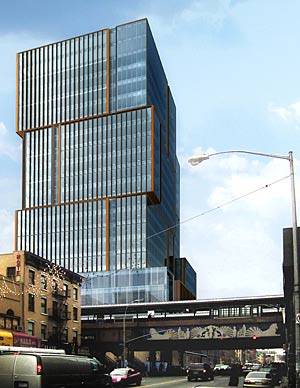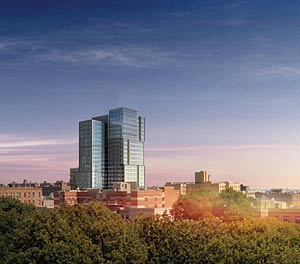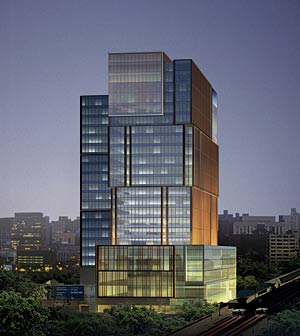

An illuminated volume at the building’s southwest corner acts like a lantern.

The tower takes the form of an irregular composition of stacked boxes, which helps mitigate its stature.
The tower replaces a parking lot located at Park Avenue and 125th Street, a gritty corner that has yet to be significantly impacted by gentrification. The site is ripe for development: situated on a street regarded as Harlem’s key economic artery, it’s also adjacent to a stop on a major commuter rail line.
Vornado Realty Trust purchased the lot last year. The development firm owns more than 20 million square feet of space in Manhattan but this will be its first project north of Central Park. It aims to attract financial service and media companies.
“We hope they are successful in getting tenants,” says Curtis Archer, president of the Harlem Community Development Corporation (HCDC), a state agency that facilitates revitalization initiatives in the neighborhood. “Harlem is primarily a residential community. It’s never been marketed as a business district until recently.”
The last major office tower constructed in the neighborhood was the 19-story Harlem State Office Building, completed in 1973. SHCA, which designed the Trump Tower on Fifth Avenue, was hired last August to design Harlem Park after developer Michael Caridi’s plan to erect a mammoth Marriott Hotel, designed by Enrique Norten, fizzled. Critics of that project, which would have occupied the same site, felt that its 51-story height clashed with the neighborhood’s aesthetic of five- and six-story brick buildings.
Roger Klein, SHCA design principal, says that his firm was mindful of those sentiments. “Instead of trying to do what architects typically do with an office tower, which is to express the verticality of the buildings, we embraced the squat and masculine forms of the Harlem neighborhood,” he explains.
The 600,000-square-foot Harlem Park takes the form of an irregular composition of stacked boxes—like Jenga blocks—that temper the building’s stature. These boxes are lined with vertical terra cotta fins that add texture to the glass curtain wall and reference the masonry of surrounding buildings. A cubic volume rises 14 feet above the roofline at the southwest corner. This apex will be illuminated at night, like a lantern gesturing south toward Central Park and the rest of Manhattan. “The goal was to create an iconic branding moment within the building,” Klein says.
The architects have also created green moments—Harlem Park aims for LEED Silver certification. Daylight penetrates throughout nearly 75 percent of the occupied space, for instance, and the plumbing system will conserve water.
Construction could begin as early as next month and is scheduled to finish in 2009. In addition to its office tenants, the building will contain 82,000 square feet of retail shops located at street level and below grade.
Harlem Park joins other recently announced projects including a 230,000-square-foot mixed-use building at the corner of Lenox Avenue and West 125th Street, and an $80-million tower on Fifth Avenue at 110th Street that will contain the Museum for African Art as well as luxury condominiums. Rejuvenation at the Park Avenue and 125th Street site had lagged. A former hub for prostitution and drug treatment clinics, homeless people still loiter there. “If Vornado moves forward,” says Thomas Lunke, HCDC’s director of planning, “a lot more attention will be paid to that corridor.”




Post a comment to this article
Report Abusive Comment